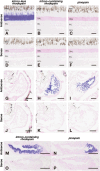Functional diversification process of opsin genes for teleost visual and pineal photoreceptions
- PMID: 39379743
- PMCID: PMC11461388
- DOI: 10.1007/s00018-024-05461-3
Functional diversification process of opsin genes for teleost visual and pineal photoreceptions
Abstract
Most vertebrates have a rhodopsin gene with a five-exon structure for visual photoreception. By contrast, teleost fishes have an intron-less rhodopsin gene for visual photoreception and an intron-containing rhodopsin (exo-rhodopsin) gene for pineal photoreception. Here, our analysis of non-teleost and teleost fishes in various lineages of the Actinopterygii reveals that retroduplication after branching of the Polypteriformes produced the intron-less rhodopsin gene for visual photoreception, which converted the parental intron-containing rhodopsin gene into a pineal opsin in the common ancestor of the Teleostei. Additional analysis of a pineal opsin, pinopsin, shows that the pinopsin gene functions as a green-sensitive opsin together with the intron-containing rhodopsin gene for pineal photoreception in tarpon as an evolutionary intermediate state but is missing in other teleost fishes, probably because of the redundancy with the intron-containing rhodopsin gene. We propose an evolutionary scenario where unique retroduplication caused a "domino effect" on the functional diversification of teleost visual and pineal opsin genes.
Keywords: Opsin; Pineal gland; Pinopsin; Retina; Retroduplication; Rhodopsin.
© 2024. The Author(s).
Conflict of interest statement
The authors declare no competing interests.
Figures






Similar articles
-
Evolutionary history of teleost intron-containing and intron-less rhodopsin genes.Sci Rep. 2019 Jul 23;9(1):10653. doi: 10.1038/s41598-019-47028-4. Sci Rep. 2019. PMID: 31337799 Free PMC article.
-
Diversification processes of teleost intron-less opsin genes.J Biol Chem. 2023 Jul;299(7):104899. doi: 10.1016/j.jbc.2023.104899. Epub 2023 Jun 7. J Biol Chem. 2023. PMID: 37295773 Free PMC article.
-
Characterization and Evolution of the Spotted Gar Retina.J Exp Zool B Mol Dev Evol. 2016 Nov;326(7):403-421. doi: 10.1002/jez.b.22710. Epub 2016 Nov 9. J Exp Zool B Mol Dev Evol. 2016. PMID: 27862951 Free PMC article.
-
Non-visual photoreception by a variety of vertebrate opsins.Novartis Found Symp. 1999;224:265-79; discussion 279-82. doi: 10.1002/9780470515693.ch15. Novartis Found Symp. 1999. PMID: 10614056 Review.
-
Expression of pineal ultraviolet- and green-like opsins in the pineal organ and retina of teleosts.J Exp Biol. 2001 Jul;204(Pt 14):2517-25. doi: 10.1242/jeb.204.14.2517. J Exp Biol. 2001. PMID: 11511667 Review.
Cited by
-
Molecular diversity of protostome non-visual opsin arthropsin.iScience. 2025 Jun 24;28(7):112989. doi: 10.1016/j.isci.2025.112989. eCollection 2025 Jul 18. iScience. 2025. PMID: 40687782 Free PMC article.
-
An Extensive Survey of Vertebrate-specific, Nonvisual Opsins Identifies a Novel Subfamily, Q113-Bistable Opsin.Genome Biol Evol. 2025 Mar 6;17(3):evaf032. doi: 10.1093/gbe/evaf032. Genome Biol Evol. 2025. PMID: 40036976 Free PMC article.

